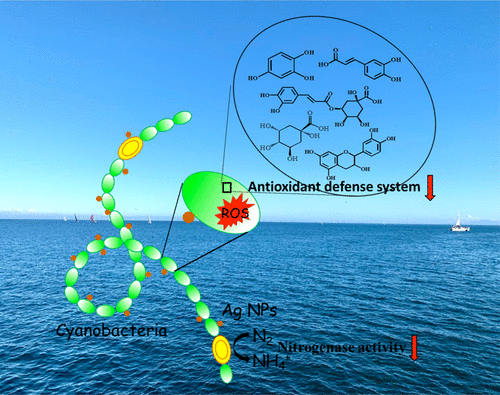当前位置:
X-MOL 学术
›
Environ. Sci. Technol.
›
论文详情
Our official English website, www.x-mol.net, welcomes your
feedback! (Note: you will need to create a separate account there.)
Low Concentrations of Silver Nanoparticles and Silver Ions Perturb the Antioxidant Defense System and Nitrogen Metabolism in N2-Fixing Cyanobacteria
Environmental Science & Technology ( IF 10.8 ) Pub Date : 2020-11-24 , DOI: 10.1021/acs.est.0c05300 Min Huang 1 , Arturo A. Keller 2 , Xiaomi Wang 3 , Liyan Tian 1 , Bing Wu 1 , Rong Ji 1 , Lijuan Zhao 1
Environmental Science & Technology ( IF 10.8 ) Pub Date : 2020-11-24 , DOI: 10.1021/acs.est.0c05300 Min Huang 1 , Arturo A. Keller 2 , Xiaomi Wang 3 , Liyan Tian 1 , Bing Wu 1 , Rong Ji 1 , Lijuan Zhao 1
Affiliation

|
Although toxic effects of silver nanoparticles (AgNPs) on aquatic organisms have been extensively reported, responses of nitrogen-fixing cyanobacteria to AgNPs/Ag+ under environmentally relevant concentrations are largely unknown. Here, cyanobacteria were exposed to different concentrations of AgNPs (0.01, 0.1, and 1 mg/L) or Ag+ (0.1, 1, and 10 μg/L) for 96 h. The impacts of AgNPs and Ag+ on photosynthesis and N2 fixation in cyanobacteria (Nostoc sphaeroides) were evaluated. In addition, gas chromatography–mass spectrometry (GC–MS)-based metabolomics was employed to give an instantaneous snapshot of the physiological status of the cells under AgNP/Ag+ exposure. Exposure to high doses of AgNPs (1 mg/L) or Ag+ (10 μg/L) caused growth inhibition, reactive oxygen species overproduction, malondialdehyde accumulation, and decreased N2 fixation. In contrast, low doses of AgNPs (0.01 and 0.1 mg/L) and Ag+ (0.1 and 1 μg/L) did not induce observable responses. However, metabolomics revealed that metabolic reprogramming occurred even at low concentrations of AgNP and Ag+ exposure. Levels of a number of antioxidant defense-related metabolites, especially phenolic acid and polyphenols (gallic acid, resveratrol, isochlorogenic acid, chlorogenic acid, cinnamic acid, 3-hydroxybenzoic acid, epicatechin, catechin, and ferulic acid), significantly decreased in response to AgNPs or Ag+. This indicates that AgNPs and Ag+ can disrupt the antioxidant defense system and disturb nitrogen metabolism even at low-dose exposure. Metabolomics was shown to be a powerful tool to detect “invisible” changes, not observable by typical phenotypic-based endpoints.
中文翻译:

低浓度的银纳米颗粒和银离子干扰N 2固定蓝细菌中的抗氧化防御系统和氮代谢。
尽管已经广泛报道了纳米银颗粒(AgNPs)对水生生物的毒性作用,但是在环境相关浓度下固氮蓝细菌对AgNPs / Ag +的反应尚不清楚。在这里,蓝细菌暴露于不同浓度的AgNPs(0.01、0.1和1 mg / L)或Ag +(0.1、1和10μg/ L)暴露96小时。评估了AgNPs和Ag +对蓝细菌(球形天蛾)光合作用和N 2固定的影响。此外,基于气相色谱-质谱(GC-MS)的代谢组学被用来提供AgNP / Ag +下细胞的生理状态的瞬时快照。接触。暴露于高剂量的AgNPs(1 mg / L)或Ag +(10μg/ L)会导致生长抑制,活性氧过量生成,丙二醛积累和N 2固定减少。相反,低剂量的AgNPs(0.01和0.1 mg / L)和Ag +(0.1和1μg/ L)不会引起可观察到的反应。然而,代谢组学表明,即使在低浓度的AgNP和Ag +暴露下,代谢重编程也会发生。与抗氧化剂防御相关的许多代谢物,尤其是酚酸和多酚(没食子酸,白藜芦醇,异绿原酸,绿原酸,肉桂酸,3-羟基苯甲酸,表儿茶素,儿茶素和阿魏酸)的含量均显着下降。 AgNPs或Ag +。这表明即使在低剂量暴露下,AgNPs和Ag +也会破坏抗氧化防御系统并破坏氮代谢。代谢组学被证明是检测“隐性”变化的强大工具,而典型的基于表型的终点无法观察到这种变化。
更新日期:2020-12-15
中文翻译:

低浓度的银纳米颗粒和银离子干扰N 2固定蓝细菌中的抗氧化防御系统和氮代谢。
尽管已经广泛报道了纳米银颗粒(AgNPs)对水生生物的毒性作用,但是在环境相关浓度下固氮蓝细菌对AgNPs / Ag +的反应尚不清楚。在这里,蓝细菌暴露于不同浓度的AgNPs(0.01、0.1和1 mg / L)或Ag +(0.1、1和10μg/ L)暴露96小时。评估了AgNPs和Ag +对蓝细菌(球形天蛾)光合作用和N 2固定的影响。此外,基于气相色谱-质谱(GC-MS)的代谢组学被用来提供AgNP / Ag +下细胞的生理状态的瞬时快照。接触。暴露于高剂量的AgNPs(1 mg / L)或Ag +(10μg/ L)会导致生长抑制,活性氧过量生成,丙二醛积累和N 2固定减少。相反,低剂量的AgNPs(0.01和0.1 mg / L)和Ag +(0.1和1μg/ L)不会引起可观察到的反应。然而,代谢组学表明,即使在低浓度的AgNP和Ag +暴露下,代谢重编程也会发生。与抗氧化剂防御相关的许多代谢物,尤其是酚酸和多酚(没食子酸,白藜芦醇,异绿原酸,绿原酸,肉桂酸,3-羟基苯甲酸,表儿茶素,儿茶素和阿魏酸)的含量均显着下降。 AgNPs或Ag +。这表明即使在低剂量暴露下,AgNPs和Ag +也会破坏抗氧化防御系统并破坏氮代谢。代谢组学被证明是检测“隐性”变化的强大工具,而典型的基于表型的终点无法观察到这种变化。











































 京公网安备 11010802027423号
京公网安备 11010802027423号